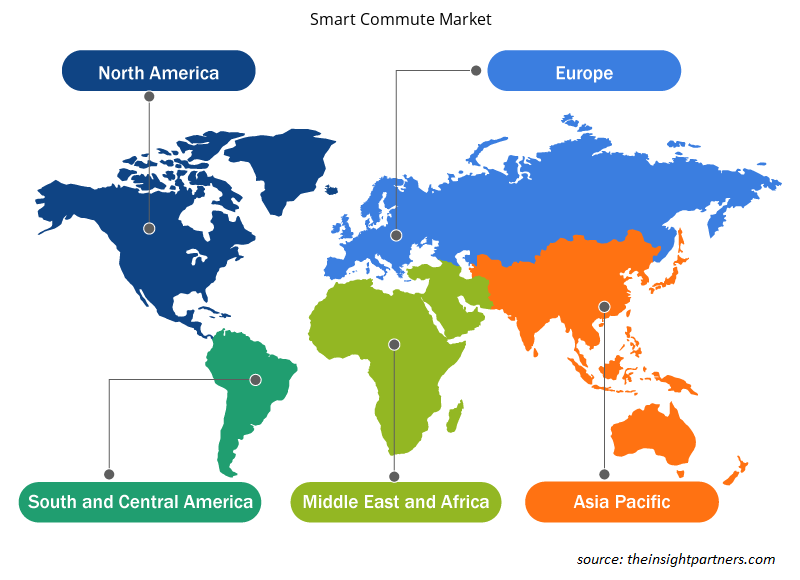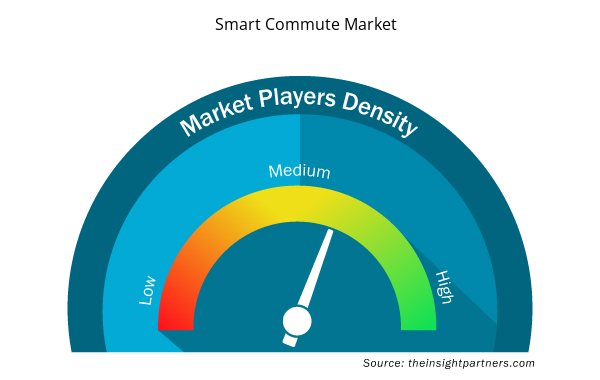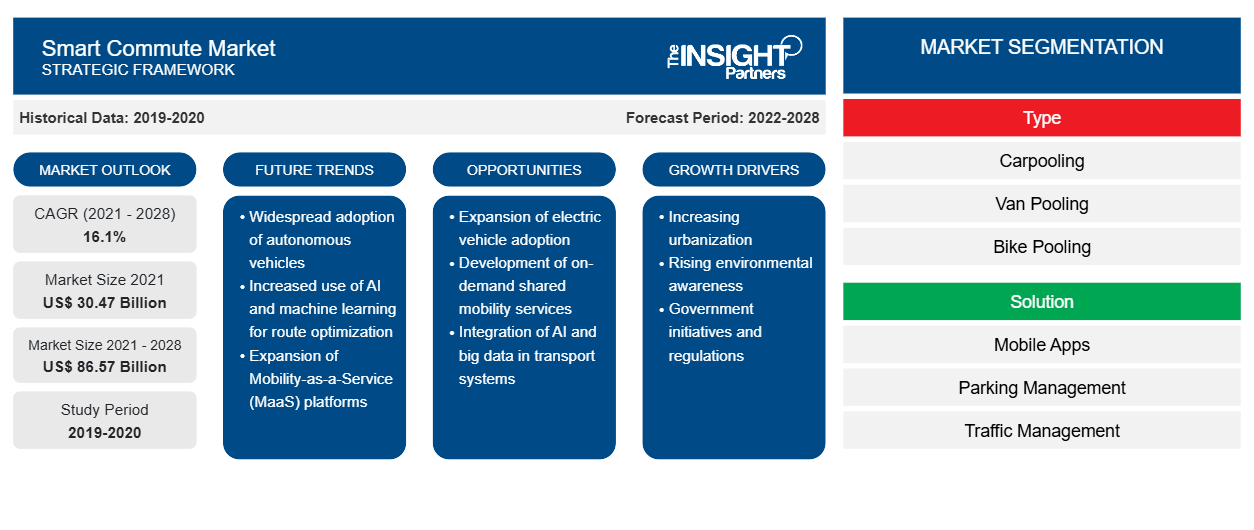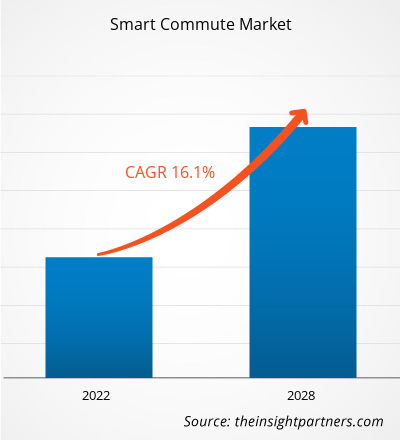智能通勤市场预计将从 2021 年的 304.6949 亿美元增长到 2028 年的 865.6873 亿美元;预计2021 年至 2028 年的复合年增长率为 16.1%。
智能通勤是指定期通过拼车、拼车、骑自行车、骑车或乘坐地铁出行。公共交通公司、政府和其他利益相关者已经制定了一套完整的战略,该战略考虑了智能出行并与公众分享,以在大都市地区建设更强大的交通。智能通勤通过减少交通拥堵和减少温室气体排放对环境产生了积极影响。
通过智能通勤服务,人们可以享受拼车、共享单车、拼车和其他环保通勤方式。它为上班族提供了一种交通选择,让他们可以选择更有效的通勤路线,从而减少交通拥堵和交通支出。推动智能通勤市场增长的因素之一是城市居民数量的增加,从而导致代际率的提高。共享交通服务已获得普遍认可,并受到政府和环保机构的鼓励,因为它有助于减少排放。它允许更少的私家车,预计将在未来几年推动智能通勤市场的增长。
在北美,办公室通勤者越来越倾向于拼车服务,这推动了智能通勤的需求,因为拼车服务可以缓解交通拥堵并防止环境破坏。此外,旅游业的兴起、技术进步和政府的优惠政策也是推动北美智能通勤市场增长的其他因素。在欧洲,移动即服务趋势的兴起和拼车服务用户群的增加预计将为市场参与者创造丰厚的机会。
在欧洲,由于对全球变暖、道路拥堵和对外国能源的依赖日益担忧,智能通勤车越来越受欢迎。2012 年实施的对单人汽车征收通行费的做法导致欧洲消费者对智能通勤的使用量大幅增加。
定制此报告以满足您的需求
您可以免费定制任何报告,包括本报告的部分内容、国家级分析、Excel 数据包,以及为初创企业和大学提供优惠和折扣
- 获取此报告的关键市场趋势。这个免费样品将包括数据分析,从市场趋势到估计和预测。
:
新冠疫情对智能通勤市场的影响
新冠疫情对交通运输行业产生了重大影响。由于新冠疫情,2020 年全球拼车和厢式货车服务需求下降。与 2019 年相比,2020 年全球智能通勤市场的收入大幅下降,部分原因是封锁以及即使在解除管制后客户也不愿使用拼车服务。拼车公司一直在努力在安全和卫生方面保持驾驶员和乘客的信心。
市场洞察–智能通勤市场
移动即服务趋势日益增强
无法购买汽车的人可以通过移动出行服务体验无缝出行。根据交通统计局的数据,假设每年行驶 15,000 公里,拥有和运营一辆汽车的平均成本约为 8,858 美元。移动即服务通过最大限度地利用拼车和叫车等交通服务,为用户降低了这些成本。它还可以减少城市的交通拥堵和汽车总排放量。因此,数字化的拼车和叫车服务可以有效地管理交通需求,并为私人汽车所有权提供方便、环保的替代方案。此外,根据统计数据,目前全球 55% 的人口居住在城市,估计到 2050 年,大约 68% 的人口将居住在城市。快速的城市化已经导致交通拥堵。移动即服务 (MaaS) 概念可能是通过更多地利用现有的公共和私人交通基础设施来减少交通拥堵的更好选择。对以更快、更便宜、更便捷的方式处理智能城市交通的有效解决方案的迫切需求,预计到 2028 年将推动 MaaS 市场的增长。因此,移动即服务 (MaaS) 的增长趋势预计将推动全球智能通勤市场的增长。
基于类型的智能通勤市场洞察
根据类型,智能通勤市场分为拼车、拼车、自行车拼车、地铁和其他。拼车细分市场预计将在全球智能通勤市场中占据重要份额,预计复合年增长率最高。智能通勤被定义为定期通过拼车、拼车、骑自行车、自行车或乘坐地铁从一个地点前往另一个地点。
基于解决方案的智能通勤市场洞察
根据解决方案,智能通勤市场细分为移动应用、停车管理、交通管理等。移动应用领域预计将在全球智能通勤市场中占据重要份额,预计将以最高的复合年增长率增长。在汽车出行方式中,移动应用的使用越来越多,以减少出行时间、成本和车辆排放。
基于最终用户的智能通勤市场洞察
根据终端用户,智能通勤市场分为个人和企业。预计企业部门将在全球智能通勤市场中占据重要份额,并且预计将以更高的复合年增长率增长。
智能通勤市场区域洞察
Insight Partners 的分析师已详细解释了预测期内影响智能通勤市场的区域趋势和因素。本节还讨论了北美、欧洲、亚太地区、中东和非洲以及南美和中美洲的智能通勤市场细分和地理位置。

- 获取智能通勤市场的区域特定数据
智能通勤市场报告范围
| 报告属性 | 细节 |
|---|---|
| 2021 年市场规模 | 304.7亿美元 |
| 2028 年市场规模 | 865.7亿美元 |
| 全球复合年增长率(2021 - 2028) | 16.1% |
| 史料 | 2019-2020 |
| 预测期 | 2022-2028 |
| 涵盖的领域 | 按类型
|
| 覆盖地区和国家 | 北美
|
| 市场领导者和主要公司简介 |
|
智能通勤市场参与者密度:了解其对商业动态的影响
智能通勤市场正在快速增长,这得益于终端用户需求的不断增长,这些需求源于消费者偏好的不断变化、技术进步以及对产品优势的认识不断提高等因素。随着需求的增加,企业正在扩大其产品范围,进行创新以满足消费者的需求,并利用新兴趋势,从而进一步推动市场增长。
市场参与者密度是指在特定市场或行业内运营的企业或公司的分布情况。它表明在给定市场空间中,相对于其规模或总市场价值,有多少竞争对手(市场参与者)存在。
在智能通勤市场运营的主要公司有:
- 布拉布拉汽车
- 通勤智能
- 企业控股公司
- ePoolers Technologies Pvt. Ltd
- 协鑫集团有限公司
免责声明:上面列出的公司没有按照任何特定顺序排列。

- 了解智能通勤市场顶级关键参与者概况
智能通勤市场的参与者主要专注于开发先进、高效的产品。
- 2022 年 1 月,多式联运移动公司 Tummoc 计划到 2022 年将业务扩展到其他十个城市,包括德里和孟买。
- 2021年4月,一家城市出行公司首次打造了整合路线和价格的应用平台,将公交、地铁、Uber、Yulu等最后一英里的选择融为一体。
公司简介
:
- 布拉布拉汽车
- 通勤智能
- 企业控股公司
- ePoolers Technologies Pvt. Ltd
- 协鑫集团有限公司
- 奥克兰智能通勤
- 快速骑行
- 交通帮助技术私人有限公司
- Uber 科技公司
- 智能通勤
- 历史分析(2 年)、基准年、预测(7 年)及复合年增长率
- PEST 和 SWOT 分析
- 市场规模价值/数量 - 全球、区域、国家
- 行业和竞争格局
- Excel 数据集


- Authentication and Brand Protection Market
- Aerospace Forging Market
- Lyophilization Services for Biopharmaceuticals Market
- Online Recruitment Market
- E-Bike Market
- UV Curing System Market
- Diaper Packaging Machine Market
- Medical Second Opinion Market
- Nuclear Waste Management System Market
- Sodium Bicarbonate Market

Report Coverage
Revenue forecast, Company Analysis, Industry landscape, Growth factors, and Trends

Segment Covered
This text is related
to segments covered.

Regional Scope
North America, Europe, Asia Pacific, Middle East & Africa, South & Central America

Country Scope
This text is related
to country scope.
常见问题
Based on type, the global Smart Commute market is segmented into carpooling, van pooling, bike pooling, metro, and others. The Smart Commute market was dominated by the carpooling segment in 2020.
North America dominated the Smart Commute market in 2020 with a share of 43.9%. Asia Pacific is expected to grow at a fastest CAGR accounting for 40.0% share by 2028, followed by Europe.
The major companies in Smart Commute market are Enterprise Holdings, Inc.; BlaBlaCar; CommuteSmart; ePoolers Technologies Pvt. Ltd.; Smart Commute; Oakland Smart Commute; Quick Ride; Tummoc (Transhelp Technologies Pvt. Ltd.); Uber Technologies, Inc.; and GCL Smart Commute Co., Ltd.
The major end user in Smart Commute includes personal, and enterprises. In terms of market share, the market was dominated by the enterprises segment in 2020.
IoT devices can be used to make daily commutes more enjoyable. These technologies also help reduce overall transport costs while being environmentally beneficial. The best IoT option for the last-mile journey could be connected bicycles. Citizens have already begun to benefit from combined bike-sharing possibilities provided by market players. Users may keep track of bike availability, usage, and trip details. The only stumbling block for linked bike-sharing programs is integrating them into today's traffic. Governments must ensure that designated bike lanes exist to maintain a smooth traffic flow. In some areas, connected electric scooters are also available for rent. Some firms even offer complimentary helmets to electric scooter riders for a minimal shipping fee. By providing alternate commute options, these businesses contribute to a better future for our world. Apps for taxi commuting are already widespread among today's youth. Rather than driving their car, many commuters use taxi services such as Uber and Lyft. This is a more cost-effective and environmentally responsible solution than single-user rides. These businesses have access to a wealth of data that may be monitored and studied to improve cab-sharing services. Unlike most public transit, they can function similarly to public transportation, but they can provide a comprehensive commute option.
The key element driving the expansion of smart commutes is a rapid increase in the adoption of carpool and bike pool services among regular office commuters. Prominent market players such as Uber and Ola offer convenient pick-up and drop-off services, attracting consumers to use ride-sharing services. Furthermore, services such as short-distance travel, intercity ride-sharing, bus-sharing, bike-sharing, and auto-sharing are available, which stimulates the expansion of smart commute demand. Many prominent Indian corporations proactively push employees to use carpool and bike pool services. Organizations with large workforces, such as Infosys, Capgemini, Cognizant, HCL, Amazon, Flipkart, Siemens, L&T, Biocon, and HDFC Bank, as well as several smaller businesses, are launching awareness campaigns and digital platforms to help employees better plan their commutes. Moreover, organizations are rewarding top carpoolers to keep employees engaged and motivated to reduce carbon emissions and traffic jams across cities. New York, Seoul, and Shanghai are among the top 10 cities with the highest carbon footprint. Governments and businesses are encouraging carpooling to commute in cities to reduce emissions. Countries have established specific targets for reducing carbon footprints by 2030 as part of the Paris climate agreement. In Delhi, India, the government implemented an odd-even strategy to control traffic density and reduce carbon emissions in the city.
Trends and growth analysis reports related to Automotive and Transportation : READ MORE..
The List of Companies - Smart Commute Market
- BlaBlaCar
- CommuteSmart
- Enterprise Holdings Inc
- ePoolers Technologies Pvt. Ltd
- Golden Concord Holdings Limited
- Oakland Smart Commute
- Quick Ride
- Transhelp Technologies Pvt Ltd
- Uber Technologies Inc.
- Smart Commute
The Insight Partners performs research in 4 major stages: Data Collection & Secondary Research, Primary Research, Data Analysis and Data Triangulation & Final Review.
- Data Collection and Secondary Research:
As a market research and consulting firm operating from a decade, we have published and advised several client across the globe. First step for any study will start with an assessment of currently available data and insights from existing reports. Further, historical and current market information is collected from Investor Presentations, Annual Reports, SEC Filings, etc., and other information related to company’s performance and market positioning are gathered from Paid Databases (Factiva, Hoovers, and Reuters) and various other publications available in public domain.
Several associations trade associates, technical forums, institutes, societies and organization are accessed to gain technical as well as market related insights through their publications such as research papers, blogs and press releases related to the studies are referred to get cues about the market. Further, white papers, journals, magazines, and other news articles published in last 3 years are scrutinized and analyzed to understand the current market trends.
- Primary Research:
The primarily interview analysis comprise of data obtained from industry participants interview and answers to survey questions gathered by in-house primary team.
For primary research, interviews are conducted with industry experts/CEOs/Marketing Managers/VPs/Subject Matter Experts from both demand and supply side to get a 360-degree view of the market. The primary team conducts several interviews based on the complexity of the markets to understand the various market trends and dynamics which makes research more credible and precise.
A typical research interview fulfils the following functions:
- Provides first-hand information on the market size, market trends, growth trends, competitive landscape, and outlook
- Validates and strengthens in-house secondary research findings
- Develops the analysis team’s expertise and market understanding
Primary research involves email interactions and telephone interviews for each market, category, segment, and sub-segment across geographies. The participants who typically take part in such a process include, but are not limited to:
- Industry participants: VPs, business development managers, market intelligence managers and national sales managers
- Outside experts: Valuation experts, research analysts and key opinion leaders specializing in the electronics and semiconductor industry.
Below is the breakup of our primary respondents by company, designation, and region:

Once we receive the confirmation from primary research sources or primary respondents, we finalize the base year market estimation and forecast the data as per the macroeconomic and microeconomic factors assessed during data collection.
- Data Analysis:
Once data is validated through both secondary as well as primary respondents, we finalize the market estimations by hypothesis formulation and factor analysis at regional and country level.
- Macro-Economic Factor Analysis:
We analyse macroeconomic indicators such the gross domestic product (GDP), increase in the demand for goods and services across industries, technological advancement, regional economic growth, governmental policies, the influence of COVID-19, PEST analysis, and other aspects. This analysis aids in setting benchmarks for various nations/regions and approximating market splits. Additionally, the general trend of the aforementioned components aid in determining the market's development possibilities.
- Country Level Data:
Various factors that are especially aligned to the country are taken into account to determine the market size for a certain area and country, including the presence of vendors, such as headquarters and offices, the country's GDP, demand patterns, and industry growth. To comprehend the market dynamics for the nation, a number of growth variables, inhibitors, application areas, and current market trends are researched. The aforementioned elements aid in determining the country's overall market's growth potential.
- Company Profile:
The “Table of Contents” is formulated by listing and analyzing more than 25 - 30 companies operating in the market ecosystem across geographies. However, we profile only 10 companies as a standard practice in our syndicate reports. These 10 companies comprise leading, emerging, and regional players. Nonetheless, our analysis is not restricted to the 10 listed companies, we also analyze other companies present in the market to develop a holistic view and understand the prevailing trends. The “Company Profiles” section in the report covers key facts, business description, products & services, financial information, SWOT analysis, and key developments. The financial information presented is extracted from the annual reports and official documents of the publicly listed companies. Upon collecting the information for the sections of respective companies, we verify them via various primary sources and then compile the data in respective company profiles. The company level information helps us in deriving the base number as well as in forecasting the market size.
- Developing Base Number:
Aggregation of sales statistics (2020-2022) and macro-economic factor, and other secondary and primary research insights are utilized to arrive at base number and related market shares for 2022. The data gaps are identified in this step and relevant market data is analyzed, collected from paid primary interviews or databases. On finalizing the base year market size, forecasts are developed on the basis of macro-economic, industry and market growth factors and company level analysis.
- Data Triangulation and Final Review:
The market findings and base year market size calculations are validated from supply as well as demand side. Demand side validations are based on macro-economic factor analysis and benchmarks for respective regions and countries. In case of supply side validations, revenues of major companies are estimated (in case not available) based on industry benchmark, approximate number of employees, product portfolio, and primary interviews revenues are gathered. Further revenue from target product/service segment is assessed to avoid overshooting of market statistics. In case of heavy deviations between supply and demand side values, all thes steps are repeated to achieve synchronization.
We follow an iterative model, wherein we share our research findings with Subject Matter Experts (SME’s) and Key Opinion Leaders (KOLs) until consensus view of the market is not formulated – this model negates any drastic deviation in the opinions of experts. Only validated and universally acceptable research findings are quoted in our reports.
We have important check points that we use to validate our research findings – which we call – data triangulation, where we validate the information, we generate from secondary sources with primary interviews and then we re-validate with our internal data bases and Subject matter experts. This comprehensive model enables us to deliver high quality, reliable data in shortest possible time.


 获取此报告的免费样本
获取此报告的免费样本